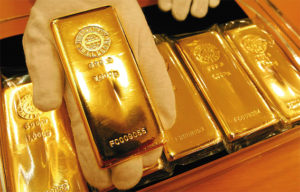 Gold futures fell on Friday, after data showed US employers added more workers than expected in February, reducing bets the Federal Reserve may slow the pace of trimming monthly bond purchases. Assets in the SPDR Gold Trust, the biggest bullion-backed ETF, rose for the first time in eight days on Friday.
Gold futures fell on Friday, after data showed US employers added more workers than expected in February, reducing bets the Federal Reserve may slow the pace of trimming monthly bond purchases. Assets in the SPDR Gold Trust, the biggest bullion-backed ETF, rose for the first time in eight days on Friday.
On the Comex division of the New York Mercantile Exchange, gold futures for settlement in April slid 0.86% on Friday to settle the week at $1 340.20 per troy ounce. Prices touched a session high at $1 353.10 per troy ounce, while day’s low was touched at $1 329.00 an ounce. The precious metal touched $1 355.00 per troy ounce on March 3rd, the strongest since October 30, as tensions between Russia and Ukraine escalated.
The yellow metal settled the week 1% higher, after a 0.2% advance in the previous 5-day period. Gold futures are up 11% this year after a rout in emerging markets and signs of slowing US growth, boosted demand for haven assets.
However, gold plunged 28% last year, the steepest annual decline since 1981 as some investors lost faith in the metal as a store of value and amid speculation Fed will continue scaling back its monetary stimulus throughout 2014.
US payrolls data “is weighing on gold,” said yesterday Tommy Capalbo, a broker at Newedge Group in New York, cited by Bloomberg. “Today’s numbers make it clear that tapering will continue.”
Fed stimulus outlook
Bullion prices were pressured on Friday after it became clear that US employers added more workers than expected in February, curbing demand for the precious metal as a store of value.
The US Bureau of Labor Statistics reported on Friday that nation’s employers added 175 000 workers to payrolls in February, after a revised up 129 000 increase in the previous month. Analysts had expected a 149 000 advance in February. At the same time, the unemployment rate unexpectedly rose to 6.7% last month from a 5-year low of 6.6% as more Americans entered the workforce, but couldn’t find a job. The US added 194 000 jobs on average, each month last year.
The report suggested that US employers were upbeat about the economic outlook, after recent winter storms and much-below-normal temperatures across the US and especially across the eastern parts of the country, slowed consumer spending, housing and manufacturing.
“The fundamentals are good,” Joe LaVorgna, chief U.S. economist at Deutsche Bank Securities Inc. in New York, commented in a Bloomberg interview before the report. “Faster job growth means faster income and more discretionary spending. Ultimately, with more business spending, not only will they hire more people, they’ll hire more capital. Everything becomes self-reinforcing.”
Federal Reserve Chair Janet Yellen said last month that central bank’s officials were “open to reconsidering” the pace of reductions in monthly bond purchase, should the economy falter, in contrast with her comments made earlier in February, that US economy has gained enough strength in order to withstand reduction of monetary stimulus.
At the same time, Fed officials will try to determine whether the weakness economy has recently demonstrated is due to temporary factors, before their next policy meeting scheduled for March 18-19th.
“Unseasonably cold weather has played some role,” Yellen said in her testimony in front of the Senate Banking Committee in February. “What we need to do, and will be doing in the weeks ahead, is to try to get a firmer handle on exactly how much of that set of soft data can be explained by weather and what portion, if any, is due to softer outlook.”
The central bank announced in December that it will pare monthly bond-buying purchases by $10 billion, after which it decided on another reduction of the same size at the meeting on policy in January, underscoring that labor market indicators, which “were mixed but on balance showed further improvement”, while nation’s economic growth has “picked up in recent quarters.”
Federal Reserve will probably continue to pare stimulus by $10 billion at each policy meeting before exiting the program in December, according to a Bloomberg News survey of 41 economists, conducted on January 10th.
Assets in the SPDR Gold Trust, the biggest bullion-backed ETP, were increased to 805.20 tons on Friday, after being unchanged for seven days, the longest streak holdings have held steady in more than a year. In 2013, the fund has lost 41% of its holdings. A total of 553 tons has been withdrawn last year. Billionaire hedge-fund manager John Paulson who holds the biggest stake in the SPDR Gold Trust told clients at the end of last year that he wouldn’t invest more money in his gold fund because it isn’t clear when inflation will accelerate. However, a government report revealed that the owner of the largest stake in the SPDR Gold Trust, kept his holdings unchanged in the fourth quarter of 2013.




